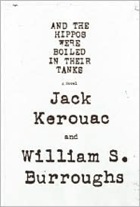 Is it something in the November air? Doubtful. Maybe it’s the god of artistic collaborations wanting to set the record straight. Let’s say it’s strictly dumb coincidence.
Is it something in the November air? Doubtful. Maybe it’s the god of artistic collaborations wanting to set the record straight. Let’s say it’s strictly dumb coincidence.
Whatever the reason, this month provides a happy occasion for legions of Jack Kerouac fans, to say nothing of William S. Burroughs cultists, who always seem eager for new revelations about both writers’ works and personalities. And if nothing else, it will add several strong threads to their already embroidered legends.
First came And the Hippos Were Boiled in Their Tanks, which has just arrived in bookstores only 64 years after William Burroughs and Jack Kerouac wrote it.
Jed Birmingham has a fascinating review at RealityStudio that discusses, among other things, why they cast its tale of murder and homosexual obsession as fiction and had to disguise the identities of the real-life characters.
[R]eviewers of Hippos have treated the book as a straight telling of the Carr-Kammerer story, more period memoir than novel. This is a dangerous practice. If we think of Hippos in terms of memoir, we have to be acutely aware of what is missing.
 Now comes the lost art of Ah POOK IS HERE, opening Friday (Nov. 14) at the Salomon Arts Gallery in downtown Manhattan. It features Malcolm Mc Neill‘s collaboration with Burroughs a mere 38 years after the two of them teamed up for a word/image novel that they tried — and, sadly, failed — to get published.
Now comes the lost art of Ah POOK IS HERE, opening Friday (Nov. 14) at the Salomon Arts Gallery in downtown Manhattan. It features Malcolm Mc Neill‘s collaboration with Burroughs a mere 38 years after the two of them teamed up for a word/image novel that they tried — and, sadly, failed — to get published.
Well, better late than never.
Mc Neill’s “ah pook” artwork includes all sorts of fantastic sketches, drawings, and cartoons. Fantastic in the true meaning of the word. One vivid panorama is so large — “End of Days,” measuring 25 feet x 24 inches — that the gallery display will have to be monumental.
425-thumb-425x114.jpg)
425-thumb-425x120.jpg)
Apart from the age disparity and the unprecedented nature of his writing, he embodied an extreme persona for which I had no frame of reference at all: an avowed homosexual heroin addict, who’d shot and killed his wife, then essentially abandoned their only child. [This was] a scenario in which none of the elements were familiar, much less made sense. The need to try and make them so, however, was irresistible.
“I accepted him at face value,” he notes, and Burroughs turned out to be “one of the sincerest, most unassuming normal people I’d ever met.”
425-thumb-423x118.jpg)
In other words, Mc Neill came to believe that art is not only prescient, but can actually make things happen. Which is not as weird as it sounds. Even Hemingway believed it. He put it this way: “The only writing that was any good was what you made up, what you imagined. That made everything come true. Like when he wrote ‘My Old Man’ he’d never seen a jockey killed and the next week Georges Parfrement was killed at that very jump and that was the way it looked.” But I digress.
425-thumb-424x131.jpg)
After starting out doing cartoons in the underground press, Mc Neill went on to a mainstream career as a high-tech artist/illustrator. His work has appeared in publications ranging from The New York Times and Rolling Stone to National Lampoon and Marvel Comics. Eventually he got into television as a “live action / effects director,” winning an Emmy, in 1984, for “Outstanding Graphics and Title Design” of the opening credits sequence for “Saturday Night Live.” Now that is weird.
(Crossposted at HuffPo)




